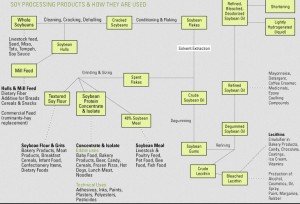Last month I wrote about genetically modified soy and whether phyto-oestrogens are a concern for hormonal imbalance. (Click here to read that article). In this article I will address whether the manufacture of soy is a concern to our health and not the actual soy itself.
Concentrating on soymilk as it is one of the most consumed s oy products worldwide. Interestingly, China originally didn’t consume high levels of soymilk and it was a product with limited processing. It was simply a water extract of whole soybeans containing all of the water soluble proteins, most of the oil and carbohydrates that naturally occur in soybeans. The traditional process was made for daily consumption – soybeans were washed, soaked overnight and ground to a slurry. Cold water added after a thorough mixing, the dilute slurry is strained through cheese cloth and pressed. The extract (soymilk) is boiled, strained again. This is a heavy, gritty liquid with a strong beany flavour and chalky mouthfeel.
oy products worldwide. Interestingly, China originally didn’t consume high levels of soymilk and it was a product with limited processing. It was simply a water extract of whole soybeans containing all of the water soluble proteins, most of the oil and carbohydrates that naturally occur in soybeans. The traditional process was made for daily consumption – soybeans were washed, soaked overnight and ground to a slurry. Cold water added after a thorough mixing, the dilute slurry is strained through cheese cloth and pressed. The extract (soymilk) is boiled, strained again. This is a heavy, gritty liquid with a strong beany flavour and chalky mouthfeel.
In the 1940’s Hong Kong started producing soy milk as a competitor for soft drink rather than as a milk alternative, even bottling in soft drink shaped bottles. By 1974 sales exceeded those of Coca Cola in Hong Kong.
Traditional soymilk didn’t do so well in the West – the “beany” flavour didn’t appeal. There is now quite a lot of processing involved to have the taste and texture attract Western consumers. To make it more appealing the process can lose some of the protein and good fat content so it’s important to look at the organic brands that use whole soy beans in their products to ensure this loss of nutrients is minimal. Look for this on the label. Or consider making your own soymilk – can be made in a similar way to nut milks. Also any other milk alternatives do undergo similar processing.
If you are thinking that soy undergoes a lot of processing then take into account any commercially made dairy milk and the considerable amount of processing this highly allergic/intolerable product undergoes. There is much more focus on destroying bacteria when it comes to dairy milk and this destruction can be a combination of heat treating and chemical treating. Also the cow’s themselves can be exposed to a greater level of chemicals not only from their food but from agricultural and veterinary exposures. Here again organic, unhomogenised milk is important if you would prefer to stick to dairy milk.
Soy sauce was the first processed soy product imported to the Western world in the 1770’s. There is some processing involved as soy sauce is fermented. Regular soy sauce uses wheat in the fermentation process, if wanting to avoid wheat, then Tamari soy sauce is ideal. Also look for reduced salt varieties as soy sauce is quite high in salt.
Miso (soybean paste) and tempeh are fermented soy products with tempeh being considered as a highly beneficial fermented food product. Tempeh is the only fermented soy product that doesn’t have salt added to it. Tempeh originated in Indonesia/Malaysia.
Tofu (bean curd) can be fermented but most commercial tofu products aren’t. Tofu comes in various textures but does start off in the same way that soymilk is processed.
If you want to enjoy soy with no processing at all, then edamame is for you! They are the green soy beans fresh in the pod. You can buy them frozen (steam them briefly) or order at any Japanese restaurant.
My advice when it comes to soy products is definitely only organic/non-GMO soy products and read labels to select products that contain whole soybeans (if possible). And remember that a lot of livestock are fed soybean meal so it can’t be all that bad! 😉
Here is a great picture that really gives an idea of how all soy products are processed.
*National Soybean Research Laboratory 2014, “Soybean processing, products and how they are used”
I feel there is more proof that soy has health benefits than detriments and all food processing/manufacture techniques should be considered in this packaged food focussed society.
*References available upon request
Megan will complete her 3 part series next month looking at how soy can influence thyroid and cardiovascular systems.


